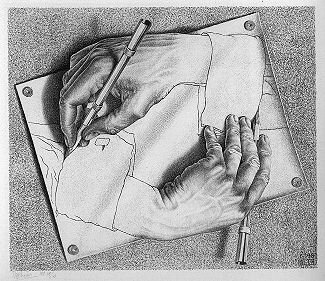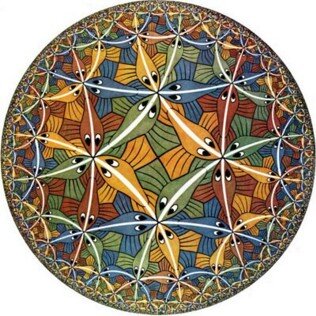I’ve been painting Penrose triangles because I see them as symbolic of the intersection of imagination and science. A simple shape made impossible by a little trickery. A mathematician and an artist help us unpack a perspective of exploring the bounds of science by using metaphor and illustration.
The Penrose triangle is an “impossible shape” popularized by psychiatrist Lionel Penrose and his son, prominent Nobel Prize-winning mathematician Sir Roger Penrose. Although invention is credited to Swedish artist Oscar Reutersvärd, the shape is named for Penrose due to the popularity of it’s usage in the 1950’s.
Sir Roger Penrose is a fascinating person known for his research in cosmology, general relativity and (more recently) “the hard problem” of consciousness. He is half recipient of the 2020 Nobel Prize in Physics "for the discovery that black hole formation is a robust prediction of the general theory of relativity."
Penrose was seeking to exhibit plain sight impossibility to describe phenomena he was studying in the theory of general relativity and it’s application in black hole theory/cosmology. In 1954 Penrose happened across an exhibition of M.C. Escher in Amsterdam. Impressed by Escher’s grasp on mathematics, and fascinated by his early illusions, Penrose and his father set to work on creating their own impossible shapes.
M.C. Escher was a Dutch graphic artist famous for his mathematical inspired creations. His 1954 exhibition that inspired Penrose likely contained works like “Drawing Hands” and “Relativity” as seen here.
Lionel and Roger Penrose set out to create the Penrose Triangle and a set of looping stairs that infinitely rise and fall. Sketches were shared with M.C. Escher who went on to use the concepts of the Penrose Triangle to create his two most famous masterpieces. “Waterfall” is also sometimes referred to as the Perpetual Motion Machine as the flowing river that turns the waterwheel continues indefinitely. “Ascending and Descending” builds on the Penrose stair concept where users could walk up or down the stairs continually, forever.
Roger Penrose often uses another M.C. Escher drawing to exhibit the properties of infinity and circular edge theory. “Circle Limit IV” is a tessellation construct showing angels and devils converging on the outer limits of their bounds. Penrose uses this analogy to describe the behavior of our universe using conformal compaction (Conformal Field Theory). From what I understand, Circle Limit III and IV were woodcut, which goes on to describe the level of talent and forsight of M.C. Escher.
I am no intellectual like Sir Roger Penrose or artist like M.C. Escher, however, I paint the Penrose triangle in homage to giants before us. I make my own original constructs of original abstract art to be colorful in your space, to be unique to your day and to remind you of how much information can be stored in a relatively simple triangle.
My current painting series is titled “Order in Abstraction” and there are original paintings available here.










